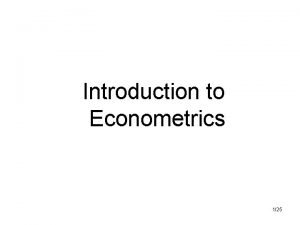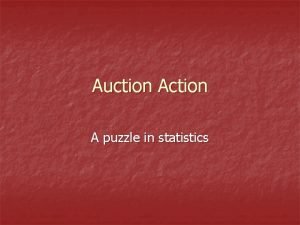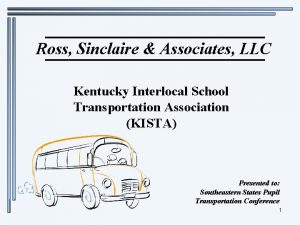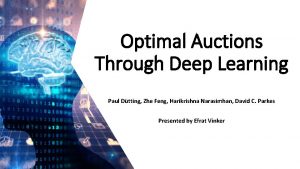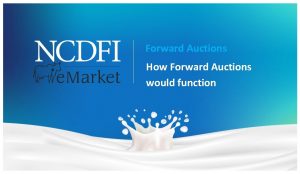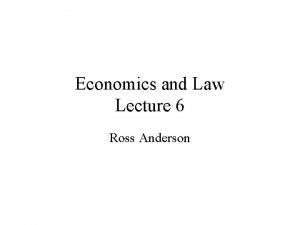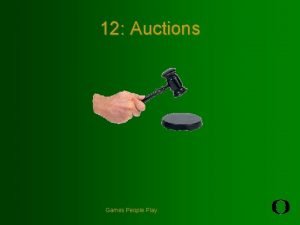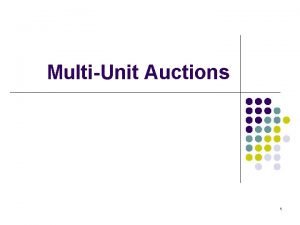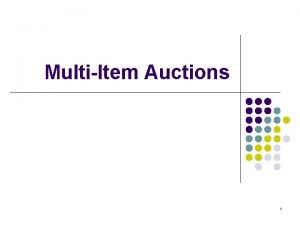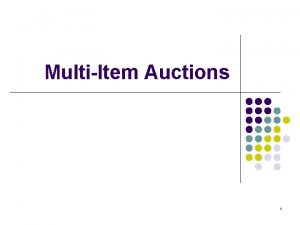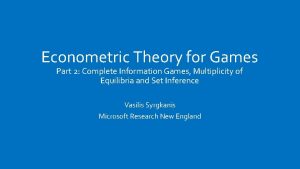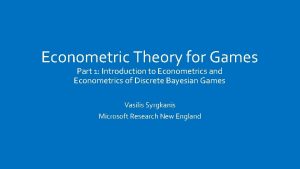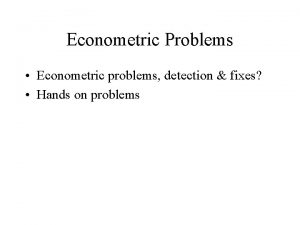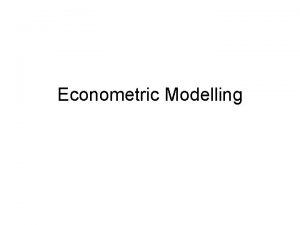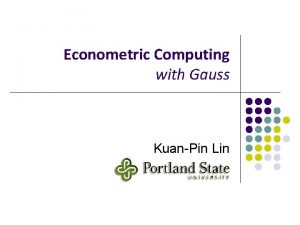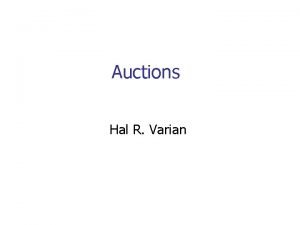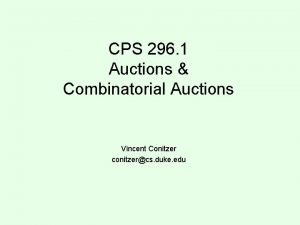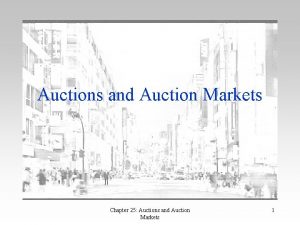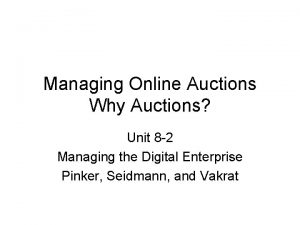Econometric Theory for Games Part 3 Auctions Identification

![Auction Games: Identification and Estimation FPA IPV: [Guerre-Perrigne-Vuong’ 00], Beyond IPV: [Athey-Haile’ 02] Partial Auction Games: Identification and Estimation FPA IPV: [Guerre-Perrigne-Vuong’ 00], Beyond IPV: [Athey-Haile’ 02] Partial](https://slidetodoc.com/presentation_image/2b21e529ee7af3d373f74dd1d085c63f/image-2.jpg)
![First Price Auction: Non-Parametric Identification [Guerre-Perrigne-Vuong’ 00] • First Price Auction: Non-Parametric Identification [Guerre-Perrigne-Vuong’ 00] •](https://slidetodoc.com/presentation_image/2b21e529ee7af3d373f74dd1d085c63f/image-3.jpg)
![First Price Auction: Non-Parametric Identification [Guerre-Perrigne-Vuong’ 00] • First Price Auction: Non-Parametric Identification [Guerre-Perrigne-Vuong’ 00] •](https://slidetodoc.com/presentation_image/2b21e529ee7af3d373f74dd1d085c63f/image-4.jpg)
![First Price Auction: Non-Parametric Identification [Guerre-Perrigne-Vuong’ 00] • First Price Auction: Non-Parametric Identification [Guerre-Perrigne-Vuong’ 00] •](https://slidetodoc.com/presentation_image/2b21e529ee7af3d373f74dd1d085c63f/image-5.jpg)
![First Price Auction: Non-Parametric Estimation [Guerre-Perrigne-Vuong’ 00] • First Price Auction: Non-Parametric Estimation [Guerre-Perrigne-Vuong’ 00] •](https://slidetodoc.com/presentation_image/2b21e529ee7af3d373f74dd1d085c63f/image-6.jpg)
![First Price Auction: Non-Parametric Estimation [Guerre-Perrigne-Vuong’ 00] • ** Need some modifications if one First Price Auction: Non-Parametric Estimation [Guerre-Perrigne-Vuong’ 00] • ** Need some modifications if one](https://slidetodoc.com/presentation_image/2b21e529ee7af3d373f74dd1d085c63f/image-7.jpg)



![Notable Literature • [Athey-Haile’ 02] • • Identification in more complex than independent private Notable Literature • [Athey-Haile’ 02] • • Identification in more complex than independent private](https://slidetodoc.com/presentation_image/2b21e529ee7af3d373f74dd1d085c63f/image-11.jpg)


![Mechanism Design for Data Science [Chawla-Hartline-Nekipelov’ 14] • Mechanism Design for Data Science [Chawla-Hartline-Nekipelov’ 14] •](https://slidetodoc.com/presentation_image/2b21e529ee7af3d373f74dd1d085c63f/image-14.jpg)
![Optimizing over Rank-Based Auctions [Chawla-Hartline-Nekipelov’ 14] • Optimizing over Rank-Based Auctions [Chawla-Hartline-Nekipelov’ 14] •](https://slidetodoc.com/presentation_image/2b21e529ee7af3d373f74dd1d085c63f/image-15.jpg)
![Estimation analysis [Chawla-Hartline-Nekipelov’ 14] • Estimation analysis [Chawla-Hartline-Nekipelov’ 14] •](https://slidetodoc.com/presentation_image/2b21e529ee7af3d373f74dd1d085c63f/image-16.jpg)
![Estimation [Chawla-Hartline-Nekipelov’ 14] • Estimation [Chawla-Hartline-Nekipelov’ 14] •](https://slidetodoc.com/presentation_image/2b21e529ee7af3d373f74dd1d085c63f/image-17.jpg)
![Fast Convergence for Counterfactual Revenue [Chawla-Hartline-Nekipelov’ 14] • Fast Convergence for Counterfactual Revenue [Chawla-Hartline-Nekipelov’ 14] •](https://slidetodoc.com/presentation_image/2b21e529ee7af3d373f74dd1d085c63f/image-18.jpg)
![Take-away points [Chawla-Hartline-Nekipelov’ 14] • Take-away points [Chawla-Hartline-Nekipelov’ 14] •](https://slidetodoc.com/presentation_image/2b21e529ee7af3d373f74dd1d085c63f/image-19.jpg)
![Econometrics for Learning Agents [Nekipelov-Syrgkanis-Tardos’ 15] • Econometrics for Learning Agents [Nekipelov-Syrgkanis-Tardos’ 15] •](https://slidetodoc.com/presentation_image/2b21e529ee7af3d373f74dd1d085c63f/image-20.jpg)
![High-level approach [Nekipelov-Syrgkanis-Tardos’ 15] Current average utility Average deviating utility Regret from fixed action High-level approach [Nekipelov-Syrgkanis-Tardos’ 15] Current average utility Average deviating utility Regret from fixed action](https://slidetodoc.com/presentation_image/2b21e529ee7af3d373f74dd1d085c63f/image-21.jpg)
![Application: Online Ad Auction setting [Nekipelov-Syrgkanis-Tardos’ 15] • Value-Per-Click Expected Payment Expected click probability Application: Online Ad Auction setting [Nekipelov-Syrgkanis-Tardos’ 15] • Value-Per-Click Expected Payment Expected click probability](https://slidetodoc.com/presentation_image/2b21e529ee7af3d373f74dd1d085c63f/image-22.jpg)
![Main Take-Aways of Econometric Approach [Nekipelov-Syrgkanis-Tardos’ 15] • Rationalizable set is convex • Support Main Take-Aways of Econometric Approach [Nekipelov-Syrgkanis-Tardos’ 15] • Rationalizable set is convex • Support](https://slidetodoc.com/presentation_image/2b21e529ee7af3d373f74dd1d085c63f/image-23.jpg)



- Slides: 26

Econometric Theory for Games Part 3: Auctions, Identification and Estimation of Value Distributions Algorithmic Game Theory and Econometrics Vasilis Syrgkanis Microsoft Research New England
![Auction Games Identification and Estimation FPA IPV GuerrePerrigneVuong 00 Beyond IPV AtheyHaile 02 Partial Auction Games: Identification and Estimation FPA IPV: [Guerre-Perrigne-Vuong’ 00], Beyond IPV: [Athey-Haile’ 02] Partial](https://slidetodoc.com/presentation_image/2b21e529ee7af3d373f74dd1d085c63f/image-2.jpg)
Auction Games: Identification and Estimation FPA IPV: [Guerre-Perrigne-Vuong’ 00], Beyond IPV: [Athey-Haile’ 02] Partial Identification: [Haile-Tamer’ 03] Comprehensive survey of structural estimation in auctions: [Paarsch-Hong’ 06]
![First Price Auction NonParametric Identification GuerrePerrigneVuong 00 First Price Auction: Non-Parametric Identification [Guerre-Perrigne-Vuong’ 00] •](https://slidetodoc.com/presentation_image/2b21e529ee7af3d373f74dd1d085c63f/image-3.jpg)
First Price Auction: Non-Parametric Identification [Guerre-Perrigne-Vuong’ 00] •
![First Price Auction NonParametric Identification GuerrePerrigneVuong 00 First Price Auction: Non-Parametric Identification [Guerre-Perrigne-Vuong’ 00] •](https://slidetodoc.com/presentation_image/2b21e529ee7af3d373f74dd1d085c63f/image-4.jpg)
First Price Auction: Non-Parametric Identification [Guerre-Perrigne-Vuong’ 00] •
![First Price Auction NonParametric Identification GuerrePerrigneVuong 00 First Price Auction: Non-Parametric Identification [Guerre-Perrigne-Vuong’ 00] •](https://slidetodoc.com/presentation_image/2b21e529ee7af3d373f74dd1d085c63f/image-5.jpg)
First Price Auction: Non-Parametric Identification [Guerre-Perrigne-Vuong’ 00] •
![First Price Auction NonParametric Estimation GuerrePerrigneVuong 00 First Price Auction: Non-Parametric Estimation [Guerre-Perrigne-Vuong’ 00] •](https://slidetodoc.com/presentation_image/2b21e529ee7af3d373f74dd1d085c63f/image-6.jpg)
First Price Auction: Non-Parametric Estimation [Guerre-Perrigne-Vuong’ 00] •
![First Price Auction NonParametric Estimation GuerrePerrigneVuong 00 Need some modifications if one First Price Auction: Non-Parametric Estimation [Guerre-Perrigne-Vuong’ 00] • ** Need some modifications if one](https://slidetodoc.com/presentation_image/2b21e529ee7af3d373f74dd1d085c63f/image-7.jpg)
First Price Auction: Non-Parametric Estimation [Guerre-Perrigne-Vuong’ 00] • ** Need some modifications if one wants unbiasedness

Uniform Rates of Convergence •

What if only winning bid is observed? •

What if only winning bid is observed?
![Notable Literature AtheyHaile 02 Identification in more complex than independent private Notable Literature • [Athey-Haile’ 02] • • Identification in more complex than independent private](https://slidetodoc.com/presentation_image/2b21e529ee7af3d373f74dd1d085c63f/image-11.jpg)
Notable Literature • [Athey-Haile’ 02] • • Identification in more complex than independent private values setting. Primarily second price and ascending auctions Mostly, winning price and bidder is observed Most results in IPV or Common Value model • [Haile-Tamer’ 03] • Incomplete data and partial identification • Prime example: ascending auction with large bid increments • Provides upper and lower bounds on the value distribution from necessary equilibrium conditions • [Paarsch-Hong’ 06] • Complete treatment of structural estimation in auctions and literature review • Mostly presented in the IPV model

Main Take-Aways • Closed form solutions of equilibrium bid functions in auctions • Allows for non-parametric identification of unobserved value distribution • Easy two-stage estimation strategy (similar to discrete incomplete information games) • Estimation and Identification robust to what information is observed (winning bid, winning price) • Typically rates for estimating density of value distribution are very slow

Algorithmic Game Theory and Econometrics Mechanism Design for Inference Econometrics for Learning Agents
![Mechanism Design for Data Science ChawlaHartlineNekipelov 14 Mechanism Design for Data Science [Chawla-Hartline-Nekipelov’ 14] •](https://slidetodoc.com/presentation_image/2b21e529ee7af3d373f74dd1d085c63f/image-14.jpg)
Mechanism Design for Data Science [Chawla-Hartline-Nekipelov’ 14] •
![Optimizing over RankBased Auctions ChawlaHartlineNekipelov 14 Optimizing over Rank-Based Auctions [Chawla-Hartline-Nekipelov’ 14] •](https://slidetodoc.com/presentation_image/2b21e529ee7af3d373f74dd1d085c63f/image-15.jpg)
Optimizing over Rank-Based Auctions [Chawla-Hartline-Nekipelov’ 14] •
![Estimation analysis ChawlaHartlineNekipelov 14 Estimation analysis [Chawla-Hartline-Nekipelov’ 14] •](https://slidetodoc.com/presentation_image/2b21e529ee7af3d373f74dd1d085c63f/image-16.jpg)
Estimation analysis [Chawla-Hartline-Nekipelov’ 14] •
![Estimation ChawlaHartlineNekipelov 14 Estimation [Chawla-Hartline-Nekipelov’ 14] •](https://slidetodoc.com/presentation_image/2b21e529ee7af3d373f74dd1d085c63f/image-17.jpg)
Estimation [Chawla-Hartline-Nekipelov’ 14] •
![Fast Convergence for Counterfactual Revenue ChawlaHartlineNekipelov 14 Fast Convergence for Counterfactual Revenue [Chawla-Hartline-Nekipelov’ 14] •](https://slidetodoc.com/presentation_image/2b21e529ee7af3d373f74dd1d085c63f/image-18.jpg)
Fast Convergence for Counterfactual Revenue [Chawla-Hartline-Nekipelov’ 14] •
![Takeaway points ChawlaHartlineNekipelov 14 Take-away points [Chawla-Hartline-Nekipelov’ 14] •](https://slidetodoc.com/presentation_image/2b21e529ee7af3d373f74dd1d085c63f/image-19.jpg)
Take-away points [Chawla-Hartline-Nekipelov’ 14] •
![Econometrics for Learning Agents NekipelovSyrgkanisTardos 15 Econometrics for Learning Agents [Nekipelov-Syrgkanis-Tardos’ 15] •](https://slidetodoc.com/presentation_image/2b21e529ee7af3d373f74dd1d085c63f/image-20.jpg)
Econometrics for Learning Agents [Nekipelov-Syrgkanis-Tardos’ 15] •
![Highlevel approach NekipelovSyrgkanisTardos 15 Current average utility Average deviating utility Regret from fixed action High-level approach [Nekipelov-Syrgkanis-Tardos’ 15] Current average utility Average deviating utility Regret from fixed action](https://slidetodoc.com/presentation_image/2b21e529ee7af3d373f74dd1d085c63f/image-21.jpg)
High-level approach [Nekipelov-Syrgkanis-Tardos’ 15] Current average utility Average deviating utility Regret from fixed action rationalizable set
![Application Online Ad Auction setting NekipelovSyrgkanisTardos 15 ValuePerClick Expected Payment Expected click probability Application: Online Ad Auction setting [Nekipelov-Syrgkanis-Tardos’ 15] • Value-Per-Click Expected Payment Expected click probability](https://slidetodoc.com/presentation_image/2b21e529ee7af3d373f74dd1d085c63f/image-22.jpg)
Application: Online Ad Auction setting [Nekipelov-Syrgkanis-Tardos’ 15] • Value-Per-Click Expected Payment Expected click probability
![Main TakeAways of Econometric Approach NekipelovSyrgkanisTardos 15 Rationalizable set is convex Support Main Take-Aways of Econometric Approach [Nekipelov-Syrgkanis-Tardos’ 15] • Rationalizable set is convex • Support](https://slidetodoc.com/presentation_image/2b21e529ee7af3d373f74dd1d085c63f/image-23.jpg)
Main Take-Aways of Econometric Approach [Nekipelov-Syrgkanis-Tardos’ 15] • Rationalizable set is convex • Support function representation of convex set depends on a one dimensional function • Can apply one-dimensional non-parametric regression rates • Avoids complicated set-inference approaches Comparison with prior econometric approaches: • Behavioral learning model computable in poly-time by players • Models error in decision making as unknown parameter rather than profit shock with known distribution • Much simpler estimation approach than prior repeated game results • Can handle non-stationary behavior

Potential Points of Interaction with Econometric Theory • Inference for objectives (e. g. welfare, revenue, etc. ) + combine with approximation bounds (see e. g. Chawla et al’ 14 -16, Hoy et al. ’ 15, Liu. Nekipelov-Park’ 16, Coey et al. ’ 16) • Computational complexity of proposed econometric methods, computationally efficient alternative estimation approaches • Game structures that we have studied exhaustively in theory (routing games, simple auctions) • Game models with combinatorial flavor (e. g. combinatorial auctions) • Computational learning theory and online learning theory techniques for econometrics • Finite sample estimation error analysis

AGT+Data Science • Large scale mechanism design and game theoretic analysis needs to be data-driven • Learning good mechanisms from data • Inferring game properties from data • Designing mechanisms for good inference • Testing our game theoretic models in practice (e. g. Nisan-Noti’ 16)

References Auctions • Guerre-Perrigne-Vuong, 2000: Optimal non-parametric estimation of first-price auctions, Econometrica • Haile-Tamer, 2003: Inference in an incomplete model of English auctions, Journal of Political Economy • Athey-Haile, 2007: Non-parametric approaches to auctions, Handbook of Econometrics • Paarsch-Hong, 2006: An introduction to the structural econometrics of auction data, The MIT Press Algorithmic Game Theory and Econometrics • Chawla-Hartline-Nekipelov, 2014: Mechanism design for data science, ACM Conference on Economics and Computation • Nekipelov-Syrgkanis-Tardos, 2015: Econometrics for learning agents, ACM Conference on Economics and Computation • Chawla-Hartline-Nekipelov, 2016: A/B testing in auctions, ACM Conference on Economics and Computation • Hoy-Nekipelov-Syrgkanis, 2015: Robust data-driven guarantees in auctions, Workshop on Algorithmic Game Theory and Data Science
 Methodology of econometric analysis
Methodology of econometric analysis Christys angels auctions
Christys angels auctions Type of auctions
Type of auctions Baystate auctions
Baystate auctions Kentucky school bus auctions
Kentucky school bus auctions Regretnet
Regretnet Ecommerce online auctions
Ecommerce online auctions Would function
Would function Anderson auctions
Anderson auctions Play auctions
Play auctions Presumptive identification vs positive identification
Presumptive identification vs positive identification Hunger games chapter 25 questions and answers
Hunger games chapter 25 questions and answers Types of games outdoor
Types of games outdoor Afte theory of identification
Afte theory of identification Kontinuitetshantering i praktiken
Kontinuitetshantering i praktiken Typiska drag för en novell
Typiska drag för en novell Tack för att ni lyssnade bild
Tack för att ni lyssnade bild Vad står k.r.å.k.a.n för
Vad står k.r.å.k.a.n för Shingelfrisyren
Shingelfrisyren En lathund för arbete med kontinuitetshantering
En lathund för arbete med kontinuitetshantering Underlag för särskild löneskatt på pensionskostnader
Underlag för särskild löneskatt på pensionskostnader Vilotidsbok
Vilotidsbok Sura för anatom
Sura för anatom Vad är densitet
Vad är densitet Datorkunskap för nybörjare
Datorkunskap för nybörjare Tack för att ni lyssnade bild
Tack för att ni lyssnade bild Debatt mall
Debatt mall
